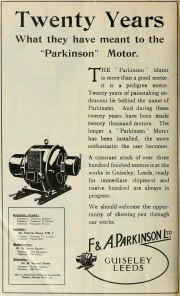Difference between revisions of "F. and A. Parkinson"
| Line 37: | Line 37: | ||
1973 Name changed to '''Crompton Parkinson Motors Ltd''' | 1973 Name changed to '''Crompton Parkinson Motors Ltd''' | ||
1992 [[BTR]] acquired [[Hawker Siddeley]] | 1992 [[BTR]] acquired [[Hawker Siddeley]]. | ||
1999 [[BTR]] and [[Siebe, Gorman and Co|Siebe]] merged; the group was renamed [[Invensys]] | 1999 The company was a non-trading agent for [[Brook Motors]]. [[BTR]] and [[Siebe, Gorman and Co|Siebe]] merged; the group was renamed [[Invensys]]. | ||
Revision as of 16:34, 5 August 2022


F. and A. Parkinson of Leeds were electrical manufacturers
1908 Frank Parkinson went into business on his own account - F. Parkinson and Co
1911 Company founded.
1913 Frank moved into manufacturing alternating-current motors with his brother, Albert, as F. and A. Parkinson. This was a union of complementary skills: Frank had a brilliant commercial brain and dominant personality while Albert proved a master of precision production engineering.
1916 They converted the company to a limited liability company and moved to new custom-built premises. The factory was organized on flow production methods and layout, unique for British industry at the time, providing significant gains in costs and quality.
1918 Private company Parkinson Motors incorporated
1920 They had an established reputation, and by adopting ball and roller bearings set the industry standard. Their culture of standardization and systematic production was adopted to match foreign competition.
1923 Company of Guiseley, Leeds. They obtained Green and Jackson as their Birmingham agents of 12, Cherry-street, Birmingham.[1].
1925 W. A. Benger was chief designer at the company but left this year to commence business on his own account as a chartered electrical engineer at 102, Albion-street, Leeds.[2]
1927 Claimed the Guiseley works as the most efficient factory in the world. Fundamental change came with a friend's remark to Parkinson, on a bus at the Institution of Electrical Engineers meeting in Nottingham, that Crompton and Co of Chelmsford had financial problems, and was under-performing in the keen competitive conditions of the 1920s. The outcome was a merger in 1927 and the creation of Crompton Parkinson[3], with Frank Parkinson as chairman. He brought the founder, Rookes Evelyn Bell Crompton, who had been excluded in a boardroom coup in 1912, back onto the board as symbol of continuity.
1932 Glassworks company established under the F. and A. Parkinson name.
1951 Maker of electric lamp bulbs; vapour discharge tubes; fluorescent lighting tubes; incandescent lamps, under trade names: Crompton and Kye.
1961 Electrical engineers and manufacturers specialising in lamps and motors. 940 employees.
1968 Hawker Siddeley acquired Crompton Parkinson
1973 Name changed to Crompton Parkinson Motors Ltd
1992 BTR acquired Hawker Siddeley.
1999 The company was a non-trading agent for Brook Motors. BTR and Siebe merged; the group was renamed Invensys.
See Also
Sources of Information
- Biography of Frank Parkinson, [1], ODNB






